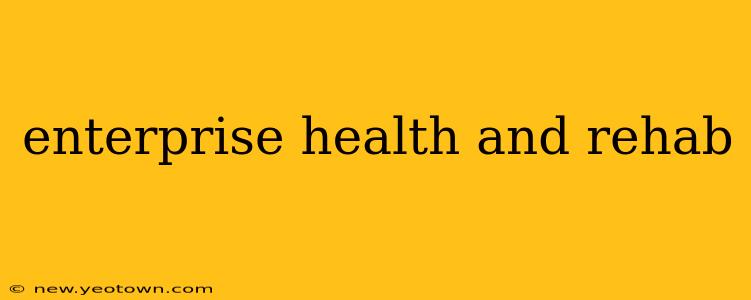The modern workplace is demanding. Long hours, high-pressure environments, and sedentary lifestyles contribute to a significant rise in employee health issues, impacting productivity, morale, and ultimately, the bottom line. This is where enterprise health and rehabilitation programs step in, offering a proactive and holistic approach to workforce wellness. But what exactly is enterprise health and rehab, and how can it benefit your organization? Let's dive in.
What is Enterprise Health and Rehab?
Imagine a program designed not just to treat injuries and illnesses, but to prevent them altogether. That's the essence of enterprise health and rehab. It's a comprehensive strategy that integrates various services to improve employee physical and mental well-being. This goes beyond traditional workplace safety measures; it's about creating a culture of health and proactively addressing potential health risks before they escalate into costly problems.
Think of it as an investment in your most valuable asset: your employees. A robust enterprise health and rehab program can encompass:
- Ergonomic assessments: Identifying and mitigating workplace hazards that contribute to musculoskeletal disorders (MSDs).
- Injury prevention programs: Training employees on safe work practices and promoting physical fitness to reduce workplace injuries.
- Early intervention and treatment: Providing access to quick and effective treatment for injuries and illnesses, minimizing downtime and promoting faster recovery.
- Wellness initiatives: Encouraging healthy lifestyles through programs such as on-site fitness centers, health screenings, stress management workshops, and health education.
- Return-to-work programs: Facilitating a smooth and safe transition for employees returning from injury or illness, preventing re-injury and fostering a supportive work environment.
What are the Benefits of Enterprise Health and Rehab?
The advantages extend far beyond simply reducing workplace accidents. A successful enterprise health and rehab program can significantly boost your organization's:
- Productivity: Healthy employees are more productive employees. Reduced absenteeism and presenteeism (being at work but not fully functioning) translate to increased output and efficiency.
- Employee morale and engagement: Investing in employee well-being fosters a positive work environment, boosting morale, job satisfaction, and employee retention.
- Reduced healthcare costs: Early intervention and prevention programs can significantly lower healthcare expenses in the long run.
- Improved company reputation: A commitment to employee well-being enhances your company's image and attracts top talent.
- Enhanced safety culture: Proactive health and safety measures create a culture of awareness and responsibility, reducing the risk of accidents and injuries.
How Do I Implement an Enterprise Health and Rehab Program?
Implementing a successful program requires careful planning and execution. Consider these key steps:
- Needs assessment: Identify the specific health risks and needs within your workforce.
- Program design: Develop a comprehensive program tailored to your organization's unique circumstances and employee demographics.
- Partnerships: Collaborate with healthcare providers, wellness specialists, and other relevant experts.
- Communication and education: Communicate the program's benefits to employees and provide ongoing education and training.
- Evaluation and improvement: Regularly evaluate the program's effectiveness and make adjustments as needed.
What are the common challenges in implementing enterprise health and rehab programs?
Implementing a comprehensive program isn't without its hurdles. Some common challenges include:
- Cost: Developing and maintaining a program requires financial investment.
- Employee buy-in: Encouraging employee participation and engagement is crucial.
- Time commitment: Implementing and managing the program requires time and resources.
- Measurement and evaluation: Tracking the program's effectiveness can be challenging.
What types of injuries are commonly addressed in enterprise health and rehab?
Musculoskeletal disorders (MSDs) like back pain, carpal tunnel syndrome, and rotator cuff injuries are frequently addressed, along with injuries resulting from slips, trips, falls, and repetitive strain. Mental health concerns like stress, anxiety, and depression are also increasingly incorporated into comprehensive programs.
How can I measure the success of my enterprise health and rehab program?
Success is measured through various metrics: reduction in workplace injuries, decreased absenteeism and presenteeism, improved employee morale, and lower healthcare costs. Key performance indicators (KPIs) should be established upfront to track progress and ensure the program's effectiveness.
Implementing an enterprise health and rehab program is a long-term investment that yields substantial returns. By prioritizing employee well-being, organizations not only improve their bottom line but also create a healthier, happier, and more productive workforce. It's a win-win situation for everyone involved.

